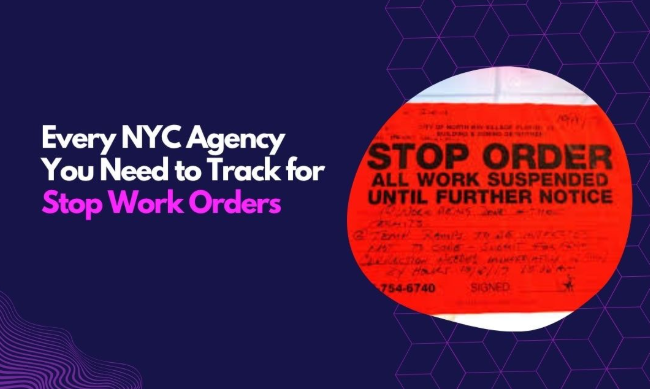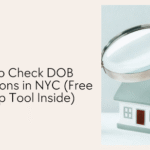Stop Work Orders don’t come with a warning. They hit hard, then stall everything. One violation. One uninspected scaffold. One unfiled permit. That’s all it takes to shut down an entire job site or lock up a rent roll. And here’s the kicker—it’s rarely one agency behind it.
Most people think the DOB is the only agency that matters. It’s not. In NYC, multiple city and state agencies have the authority to issue Stop Work Orders, sometimes without even coordinating with one another. If you’re missing even one agency from your compliance radar, you’re exposed.
This article breaks down exactly who you need to track. We’ll walk through each agency, explain what they look for, and how they issue Stop Work Orders—so you can get ahead of them before they hit your wallet.
Here’s what you’ll walk away with:
- A clear list of every NYC agency that issues Stop Work Orders (it’s more than you think)
- What each agency enforces, from asbestos to sidewalk sheds
- Which violations automatically trigger job shutdowns
- The fastest way to track all Stop Work Orders in one place
- A smarter system for keeping your sites and assets active
Skip the paperwork panic. Stop Work Orders aren’t random. Once you know where they come from, you can shut them down before they shut you down.
Who Can Actually Issue a Stop Work Order in NYC
Do you think Stop Work Orders only come from the Department of Buildings? That’s the first mistake most people make. In reality, multiple government agency offices across New York City can halt your job, shut your operations, or block your progress—each enforcing different rules, codes, and safety regulations. Some agencies are obvious. Others fly under the radar until they’re pinning a notice to your fence or front door. Missing even one puts your entire construction project at risk.
Here’s a clear, no-nonsense breakdown of the parties involved you need to track:
- DOB (Department of Buildings): The most active issuer. You’ll get hit for unpermitted building permits, unsafe site conditions, scaffolding issues, zoning violations, missing tenant protection plans, or work that violates code. When inspectors spot an unsafe or hazardous condition, they can issue a Stop Work Order on the spot—no warning, no appeal.
- HPD (Department of Housing Preservation and Development): They’re watching for tenant safety. Property owners running illegal conversions, ignoring heat complaints, or leaving repairs unfinished after an initial violation risk enforcement. If a building fails to meet HPD’s safety protocols, work can be stopped until remedial work is completed.
- FDNY (Fire Department of New York): From blocked exits to exposed fuel tanks, FDNY shuts down any site operating in an unsafe manner. Before lifting a Stop Work, they require full clearance, permits, and sometimes a formal re-inspection, especially for sites flagged during surprise inspections.
- DEP (Department of Environmental Protection): The DEP steps in when noise, dust, or contaminated runoff threaten public health. They issue violations when inspectors determine there’s a breach in environmental controls, like asbestos mishandling or unauthorized stormwater discharge.
- DOH (Department of Health): If work performed impacts health conditions—mold exposure, rodent infestation, or poor sanitation—DOH can step in. A Stop Work Order may follow until hazards are cleared and verified.
- DOT (Department of Transportation): Street excavation or scaffold installation without DOT clearance will stop your job fast. Public right-of-way issues fall under DOT’s scope, and penalties assessed can delay projects long after compliance.
- DSNY (Department of Sanitation): Improper debris handling, overflowing dumpsters, or dust blowing onto sidewalks can lead to a Stop Work Order from DSNY, especially on jobs that repeatedly ignore safety regulations or disrupt the community.
- DEC (Department of Environmental Conservation): Projects near wetlands or using hazardous materials are on DEC’s radar. They issue violations when construction puts natural resources or soil conditions at risk.
- ECB (Environmental Control Board): While ECB doesn’t enforce on-site, it carries the weight. Unresolved summonses from other agencies go through ECB, and failing to act can lead to legal holdups or civil penalties. If ignored, your permits may be frozen, or legal action may follow.
- DOF (Department of Finance): Financial violations—like unpaid fines or liens—can impact DOB processing. If you’ve got open balances, your ability to resume work covered by permits is blocked until everything is cleared.
Each agency operates independently. There’s no single portal. No master timeline. One surprise inspection, and your site can shut down—protect workers, yes, but cost you time and money if you weren’t tracking the right systems.
Understanding who can issue and what they look for is your first step. Knowing how to monitor them all in one place is your next.
What Each NYC Agency Actually Enforces on Site
A Stop Work Order doesn’t show up because of a random oversight. Each agency follows a clear set of triggers. Know what they enforce, and you cut your risk of a shutdown in half.
Below is what each agency actually looks for, broken down by focus area, not vague policy.
DOB – Structural, Safety, and Permit Compliance
- Unpermitted construction
- Unsafe scaffolding, cranes, or hoists
- Work violating zoning or building code
- Failure to maintain tenant protection plans
- Unsafe excavation or underpinning
- Incomplete inspections tied to active permits
HPD – Tenant Safety and Residential Conditions
- Illegal basement or single-room occupancies
- Missing self-closing doors or window guards
- Construction without a tenant notice
- Hazardous living conditions in rent-regulated units
- Repeated Class C violations or heat/hot water issues
FDNY – Fire Protection and Emergency Access
- Obstructed egress routes
- Unpermitted storage of flammable materials
- Blocked fire hydrants or access roads
- Missing or non-functioning fire alarms/sprinklers
- Unauthorized hot work without a fire watch
DEP – Environmental Hazards and Controls
- Asbestos removal without proper permits
- Lead dust from interior demolition
- Noise over construction limits
- Improper stormwater control or drainage issues
- Unfiltered emissions from on-site generators
DOH – Health Hazards in Occupied Spaces
- Construction dust or debris contaminating livable areas
- Poor ventilation during interior gut renovations
- Mold or rodent outbreaks due to poor cleanup
- Unsanitary plumbing during occupied upgrades
DOT – Street Work, Sidewalk Sheds, and Encroachments
- Sidewalk sheds installed without a DOT permit
- Dumpsters or lifts on public roads without clearance
- Unprotected pedestrian paths near work zones
- Unpermitted street cuts or paving jobs
DSNY – Construction Debris and Sanitation
- Open dumpsters attract pests
- Dust and debris tracking onto sidewalks
- Overflowing refuse tied to demolition or renovation
- Improper disposal of construction waste
DEC – Environmental Compliance and Waste Handling
- Construction near wetlands or sensitive zones
- Unfiled hazardous material reports
- Discharge into sewer systems from job sites
- Improper storage of solvents or fuels on-site
ECB – Enforcement Arm of Multiple Agencies
- Fails to issue a Stop Work directly
- Issues OATH summonses for outstanding safety, health, or environmental violations
- Can escalate unresolved violations to DOB-triggered job stoppages
DOF – Financial Noncompliance That Delays Work
- Lien filings tied to unpaid property fines
- Delays on DOB work permits due to unpaid ECB penalties
- Holds on Certificates of Occupancy due to financial noncompliance
This is the layer most people skip over. Understanding which agency enforces what helps you track the right data, assign the right teams, and avoid crossing invisible lines.
Violations That Lead Straight to a Job Shutdown

Not all violations trigger a Stop Work Order. Some come with warnings. Others come with a padlock. The agencies don’t always say which infractions lead to a hard stop, but patterns make it clear—some violations carry immediate consequences. Here’s what consistently triggers a shutdown across NYC agencies:
- Unpermitted Structural Work: Any structural work without approved permits—foundation, steel, framing, excavation—gets flagged instantly. Especially when tied to active site conditions or tenant complaints.
- Unsafe Scaffolding or Sidewalk Shed Installations: Improperly installed scaffolds, missing guardrails, or unsupported sheds next to pedestrian paths are treated as emergency hazards. FDNY and DOB can shut the site down on inspection.
- Active Work with Class 1 or Class C Violations: If you’re working while a property has open Class 1 DOB or Class C HPD violations (especially involving tenant safety), you risk a Stop Work Order until those issues are cleared.
- Asbestos or Lead Work Without Proper Filing: Unfiled or unmonitored asbestos or lead abatement—especially during demo or interior work—can trigger full shutdowns by DEP or DOH, no questions asked.
- Hot Work Without Fire Watch or Permit: Torch operations, welding, or flame-cutting without an active FDNY permit and trained fire watch? It only takes one unannounced inspection to halt everything.
- Blocked Egress or Fire Access: Stairwells blocked with debris. Fire exits sealed for “temporary” storage. No access to hydrants. All trigger fast shutdowns under fire code enforcement.
- Work on Vacant or Unsafe Buildings Without DOB Approval: Any activity inside a building flagged as unsafe or partially vacated (without clearance or a tenant protection plan) usually leads to a swift job stop.
- Improper Equipment on Public Right-of-Way: Boom lifts or dumpsters on sidewalks and roadways without active DOT authorization are immediate grounds for work stoppage. DOT enforcers don’t delay.
- Unpaid OATH Summonses for Critical Safety Violations: Once unpaid fines reach a certain level tied to health or safety, DOB and other agencies can suspend work permits or halt work entirely.
If you’re dealing with any of the above, you’re not facing a delay—you’re already in shutdown territory.
One Central System to Track Stop Work Orders Without Falling Behind
You can dig through NYC Open Data. Refresh each agency’s portal. Cross-reference complaint numbers, permit IDs, and violation codes. But by the time you’ve pieced together what’s actually happening, the job’s already stalled—and the fine is already clocking interest. Manual tracking isn’t built for the pace or complexity of NYC enforcement.
The fastest way to stay ahead is to automate it. Not with spreadsheets. Not with sticky notes on a whiteboard. You need a dedicated platform—something designed specifically to track, sort, and alert you the moment a Stop Work Order lands or escalates.
That means using a purpose-built digital solution. Something built to:
- Pull violation data directly from DOB, HPD, FDNY, and more
- Flag Stop Work Orders automatically across all agencies
- Organize violations by address, portfolio, or project
- Send instant alerts before deadlines or inspections
- Show resolution status without toggling between ten open tabs
This isn’t a nice-to-have. It’s the difference between catching an issue early and explaining to your team why the entire job is on pause.
Several tools exist for work order and compliance management. But the only one built specifically for NYC—and the one local pros already trust—is ViolationWatch.
Why ViolationWatch is Built for NYC Stop Work Orders
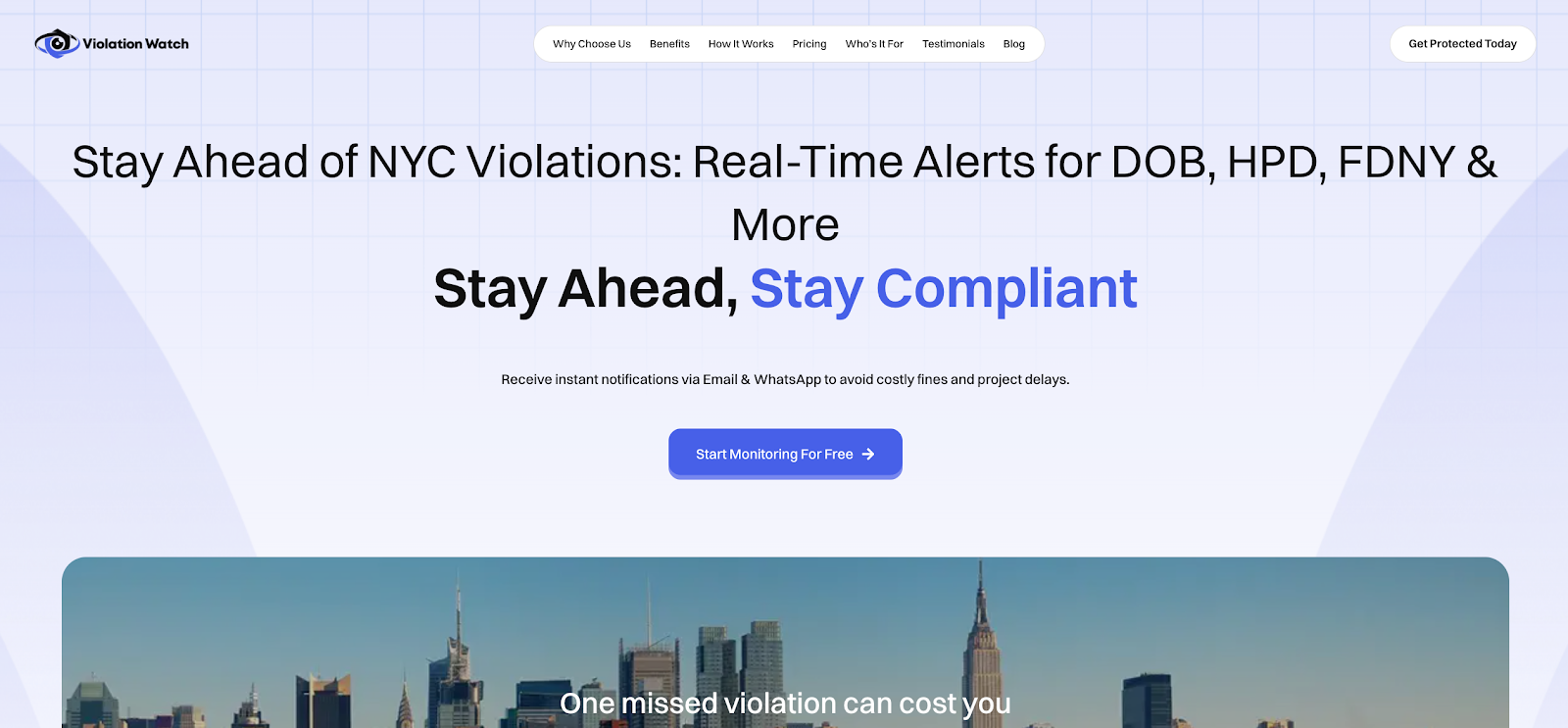
When you’re managing multiple addresses across the five boroughs, staying ahead of Stop Work Orders takes more than good timing. You need a system that doesn’t sleep—one that knows the second a violation hits any agency database.
ViolationWatch was built exactly for that. It’s a fully automated, NYC-specific compliance platform that pulls live violation data across DOB, HPD, FDNY, DEP, DOH, and more. No filters. No delays. No blind spots. That kind of speed makes a real difference on active construction sites, where every delay snowballs into lost time and mounting costs.
Let’s break down how it works—and why it makes sense if you’re serious about staying ahead of shutdowns.
- Track Everything From One Dashboard: Once you sign up and add your properties, ViolationWatch gets to work. It connects your addresses directly to NYC’s enforcement sources and starts tracking across all major agencies in real time. No switching between portals. No scraping PDFs. You see every open, closed, or recent violation tied to each property—Stop Work Orders included—all in one screen. That kind of visibility gives building owners full control without micromanaging.
- AI-Powered Scanning and Smart Alerts: ViolationWatch doesn’t wait for you to check in. It’s always on, using AI to scan databases and flag critical issues the second they appear. You’ll get instant WhatsApp and email alerts the moment something changes—whether it’s a new DOB Class 1 or an HPD escalation that could lead to a full site stop. That alert could mean catching unsafe work conditions before enforcement does. Notifications can go to multiple contacts, so supers, PMs, and compliance leads all stay on the same page.
- Works for One Address or a Whole Portfolio: Whether you’re managing a walk-up in the Bronx or twenty assets spread across Brooklyn and Queens, ViolationWatch scales with you. Monitor one building or monitor one hundred—the interface stays clean, fast, and centralized. Need to track multiple jobs, permits, or violation types? You can sort by location, date, or agency in seconds. Whether it’s about code, fines, or public safety, the right alert reaches the right team, right away.
- Pricing That Makes Sense: You can start with a free trial—no credit card, no setup cost. One address, limited to 311 data, with basic access and a 48-hour delay on alerts. If you’re serious about keeping your site safe, the $9.99/month per-address plan gets you everything:
- Unlimited violation and compliance tracking
- Real-time alerts powered by AI
- Access to all original records
- Multi-location monitoring in one dashboard
- Notifications are routed to multiple team members
No hidden fees. No bloated features. No delays. ViolationWatch is built for what matters—keeping your sites open, compliant, and protected.
How It Works?
- Sign up and add your properties

- ViolationWatch starts scanning every agency in real time
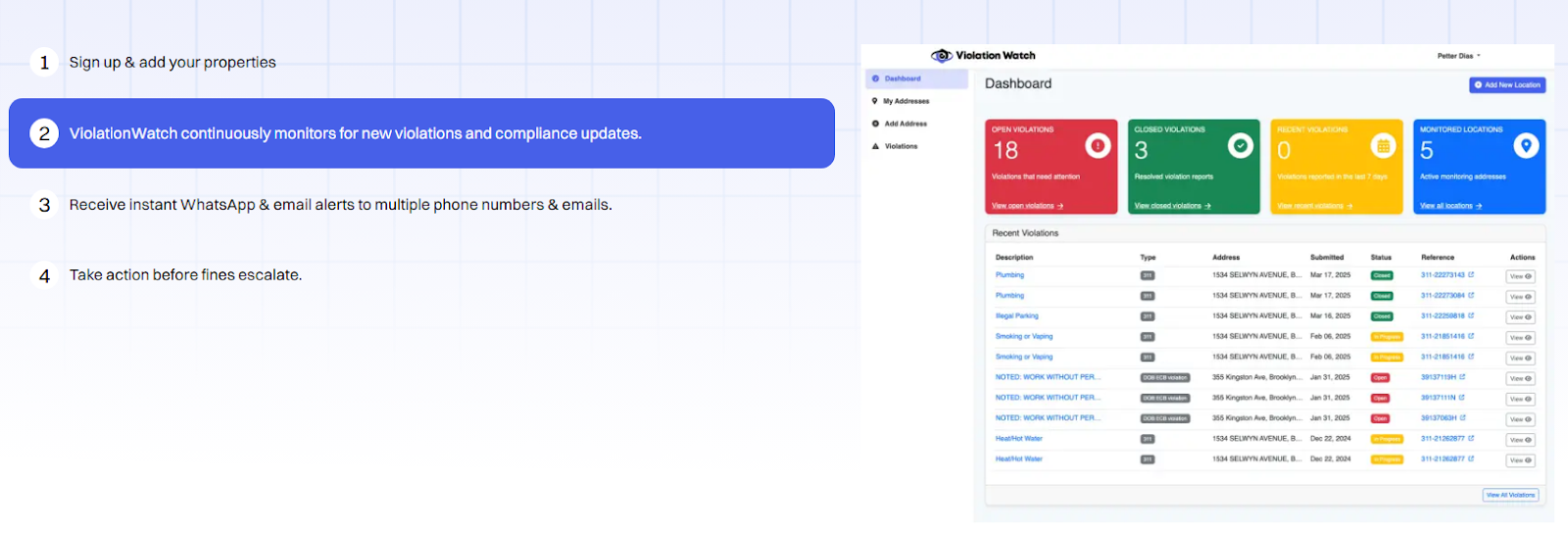
- Instant alerts are sent to your email or WhatsApp
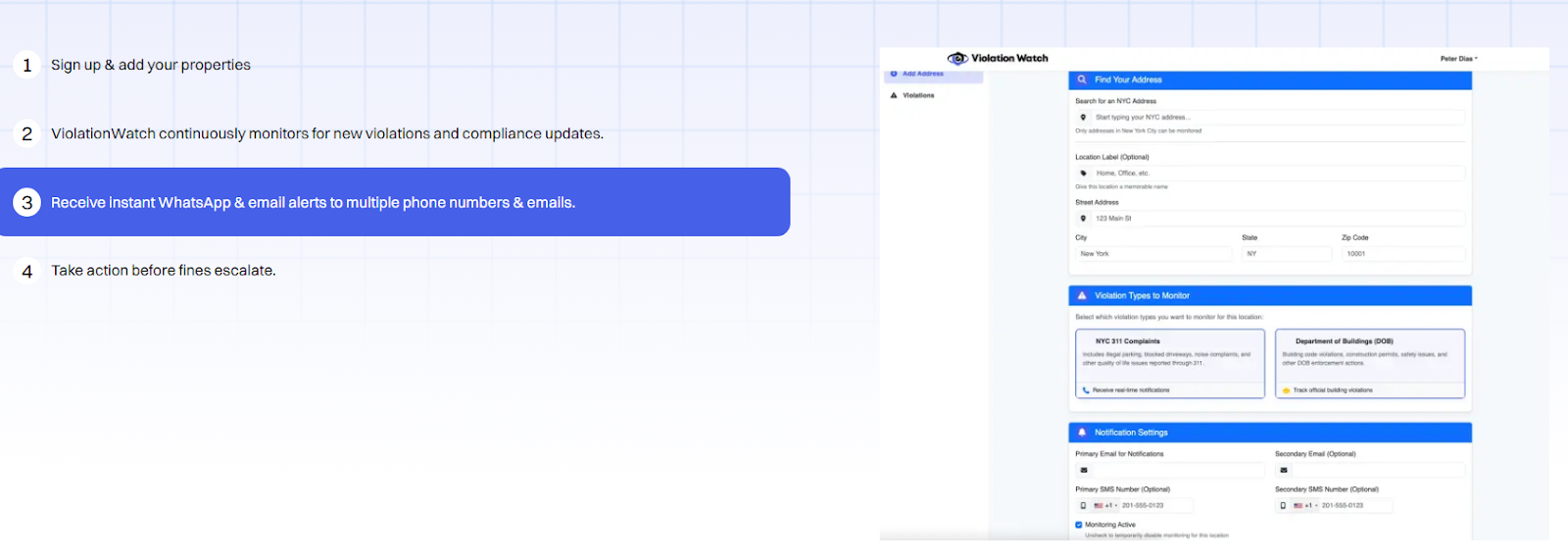
- You act fast, before fines escalate or work is stopped
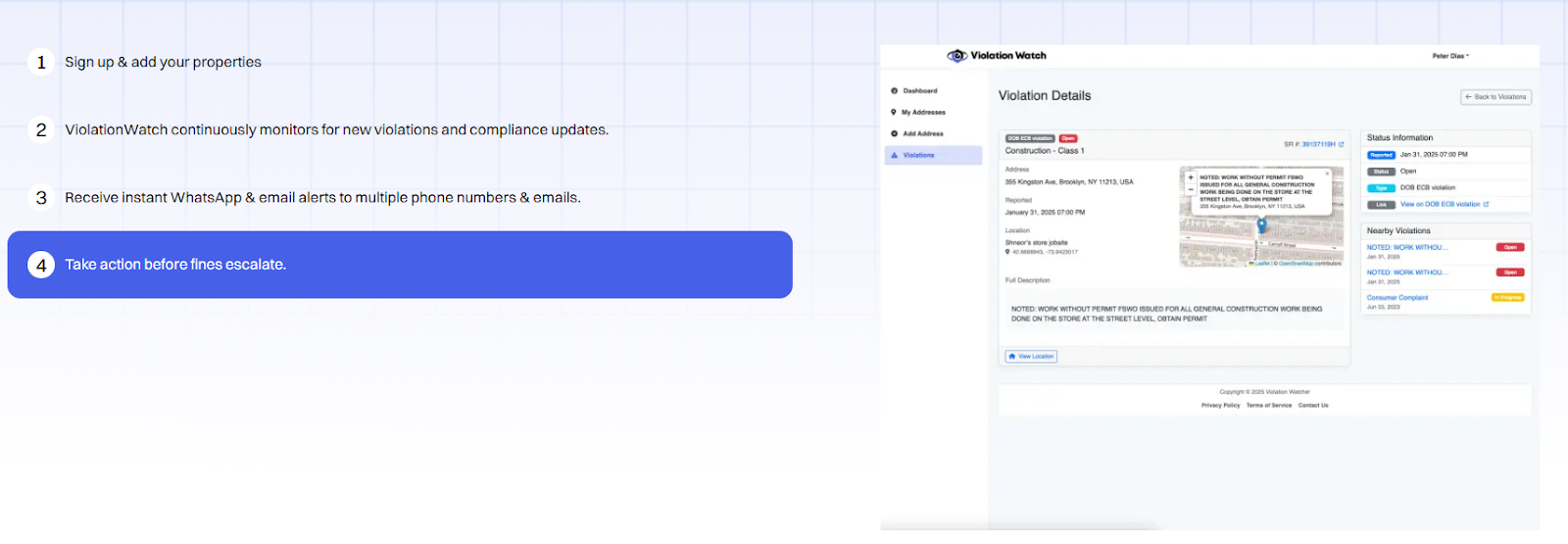
If you’re managing compliance in NYC, Stop Work Orders aren’t a surprise. They’re a pattern. ViolationWatch spots that pattern before it hits your job site.
Tracking NYC Stop Work Orders Is Easier When You Know Where to Look
You’re no longer reacting to Stop Work Orders. Now, you’re ahead of them. When you know which agencies pull the trigger, what violations actually stop the clock, and how to track them across every property without jumping between systems, you work smarter. You catch the risk before it lands. You keep jobs moving. You protect revenue, timelines, and client trust.
What happens next looks different:
- You spot a violation the moment it hits instead of days later
- You resolve issues before inspectors return instead of paying penalties
- You track everything across all buildings at once without spreadsheets
- You stop scrambling and start planning around real-time data
That’s not theory. That’s what ViolationWatch delivers—a full-stop prevention system built for NYC’s real-world enforcement. Let the city agencies keep doing what they do. Now, you’ve got a tool that keeps up.
Recommended For You
Need help tracking violations, getting alerts, or managing multiple properties?
Sign up for updates from NYC agencies or rely on compliance monitoring tools to keep you in the loop.

